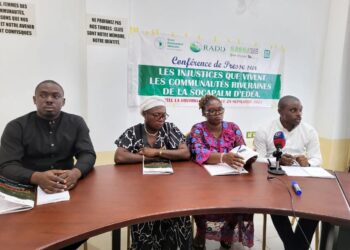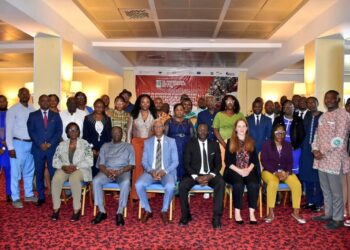Story, Louvier Kindo Tombe
In a dimly lit hall in Kribi, Chief Njongo sat upright, his hands clasped tightly on the polished wooden table. His eyes, usually steady and commanding, widened as the words sank in. Around him, fellow chiefs shifted uneasily in their chairs—some whispering, others shaking their heads in disbelief. The news was stark: Camvert’s oil palm operations might be illegal, in violation of Cameroon’s forest conversion laws and environmental regulations.
For a man who had spent decades defending his community and its lands, the revelation was almost unbearable.
“I am shocked to learn today that Camvert has been operating in total illegality because there are legal lapses in the way they were implanted,” said His Royal Majesty Ndjonkou Njongo, chief of Ebodje village in Campo.
Leaning back, Chief Njongo stared blankly at the maps and reports spread before them. The weight of responsibility pressed heavily.
“So they gave a damn to our livelihoods,” he finally said, his voice low but resolute.
The chiefs’ immediate reaction was a mix of disbelief, anger, and urgency.
A workshop that sparked legal awareness

The revelations emerged during a legal workshop in Kribi, South Region of Cameroon, organized by the civil society group Green Development Advocate (GDA). For two days, the chiefs—mostly third-class rulers directly affected by the project—were briefed on laws surrounding forest conversion, land use, and corporate accountability.
GDA explained that Camvert’s operations stood on shaky legal grounds.
“From all indications, Camvert is not a public service administration and so should not have been a beneficiary of the declassified portion of forest,” said Alain Fabrice Mfoulou, jurist and political analyst at GDA.
According to his analysis, Camvert cannot claim ownership of the land because it still belongs to the State’s Private Domain, which by law cannot be transferred to a national domain as in the case of Camvert’s concession.
At the end of the workshop, the chiefs reached a stark conclusion:
“Camvert does not have a birth certificate.”
What began as shock quickly turned into resolve. The chiefs realized they had not only a moral duty but also a legal right to defend their lands.
“Learning about the legal frameworks gave us clarity,” reflected Chief Parfait Ondo Pie of Bitande Assok in Campo. “Defending our land is not just a moral duty—it is a legal right.”
Chief Njongo echoed this new confidence:
“We now have arguments at our disposal to challenge the existence of Camvert. The ball is now in our court.”
Birth of a Council of Chiefs
In that moment of revelation, the chiefs began brainstorming. Out of the tension and determination, the idea of a Council of Chiefs was born—a united front to confront Camvert, coordinate responses, and protect Campo’s forests and people.
Armed with legal knowledge, the chiefs’ council is preparing to engage government institutions, the media, and environmental groups to amplify their communities’ concerns.
“With this council, we shall now be more united, and we will act as one. Camvert must understand that our people and our forests are not for sale,” another chief emphasized.
Organized resistance to Camvert’s expansion
The chiefs see a critical opening: Camvert’s five-year mandate in Campo is nearing its end. So far, the company has exploited less than 20% of the forest allocated to it.
“If with just about seven hectares exploited we are already facing such dangers, what will happen if the company exploits all of its 40 hectares?” one chief lamented, citing growing human–wildlife conflicts caused by the project.
Their struggle now focuses on two key demands:
1. Prevent the renewal of Camvert’s mandate.
2. Reclaim ownership of the forest for traditional management at village level.
The chiefs argue that the company has failed to fulfill its mandate, and any unexploited land at the end of the agreement should revert to them. They are also pressing for access to the remaining 20 hectares of the initial 60.
“It’s going to be a difficult task, but as we constitute ourselves into a council and seek legal expertise, we shall be able to forge ahead,” said Chief Njongi.
Evaluating Camvert’s actions
The Kribi workshop also allowed the chiefs to review Camvert’s activities in their villages. While some communities reported receiving token support—solar lamps, financial gifts, or minor road works—others said they had gained nothing at all.
“We really need clarifications on these issues because we are not sure if what they give is what we deserve,” one chief remarked. “Even the different companies in Campo need to clearly define their status—whether they are under Camvert or partnering with Camvert.”
During discussions, Alain Fabrice Mfoulou of GDA trained the chiefs on how to calculate the benefits from forest exploitation. He presented a community guide to them on “access of indigenous people’s and local communities in Cameroon to the benefits derived from land concessions (Agro-industries), and forestry concession (sale of timber and FMU)”.
They discovered that financial channels meant to deliver community benefits were ineffective, and demanded that all payments be deposited directly into accounts managed by the chiefs themselves. To this end, they resolved to open separate bank accounts for transparency and accountability.
Looking ahead
As the chiefs left Kribi, they carried with them more than outrage—they carried a clear strategy. Their main resolution was to formally establish the Council of Chiefs and to demand representation in all communal decision-making platforms.
What began as a workshop has become the foundation of an organized resistance—traditional rulers standing together, determined to ensure that Campo’s forests and communities are defended from exploitation.








